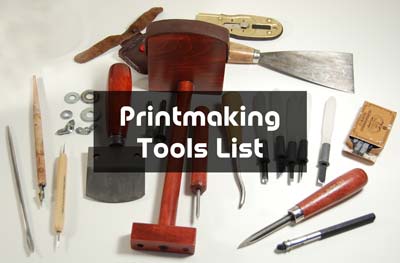
The smell of fresh ink.
The lush weight and texture of a master plate.
Even the mere sight of an etching tool is enough to persuade a printmaking artist to pick up his tool and print away!
Yes, the world of printmaking is that much fascinating.
And seeing how a beautiful texture or pattern is repeating itself over and over again gets even the little kids all revved up with creativity!
Want to get caught up with this magical artwork too?
We have prepared a printmaking tools list to get you started on the right foot!
But, first, let’s welcome you to this world with a bit of a background story to get you hooked!
What Is Printmaking?
Printmaking is a form of art that has gained popularity within the last century.
One of the first uses was in the 7th century when a Chinese artist drew a picture on a wooden block and then later transferred that image on fabric and paper.
Soon after that incident, it became a trend to use the printmaking process to make copies of the artist’s paintings and drawings. These copies had a charm of their own, not to mention, the price was pretty affordable as well compared to the original artwork!
So, the process of printmaking is quite simple.
A printmaker draws or etches a picture onto a matrix (It could be anything, e.g. Stone, Metal plate, Wooden block). The image is then coated with fresh ink. Finally, it’s transferred to another medium (e.g. Paper or Fabric) and pressed with hand or a roller press to reveal a beautiful final product!
Thus, you can create numerous copies from just one matrix.
Types Of Printmaking
There are 4 different types of printmaking trending. And each one of them comes with some unique characteristics and techniques.
Intaglio Printmaking
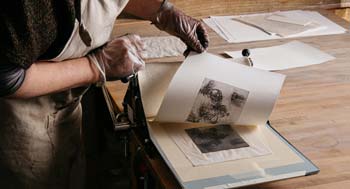
Intaglio artwork basically involves etchings and engravings of different things. It’s made by using a sharp V-shaped tool to cut into a smooth metal surface. To develop the final print, there are different techniques involved including Etching, Engraving, Drypoint and Mezzotint.
Relief Printmaking

It’s also known as Block printing.
This process requires a raised exterior. It could be a block of wood, metal or plastic surface. The idea is to spread ink onto the surface with the help of a roller until it becomes a bit sticky. Then use a fresh roller to press the pattern onto the desired surface/paper carefully.
Lithography
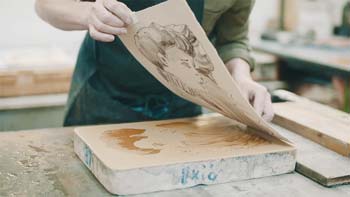
Lithography is the process of printing art from a stone or flat metal plate. It relies on two things to work: Grease and water.
The artist first applies ink and water on a grease-treated image that’s on the flat metal plate. The greasy areas absorb the ink, the moisture areas do not. The inked plate is then directly printed on the desired surface.
Read our related article on Lithographic Printing Advantages (and disadvantages!)
Serigraphy (Screen Printing)
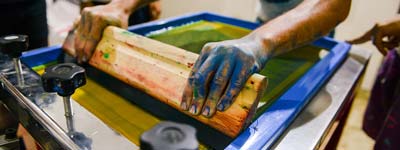
Serigraphy or Screen printing is used by commercial industries to decorate T-shirts and posters.
It’s a process of pressing ink through a stencil and create a particular design on the desired material. usually, fabric and paper are the two most popular mediums to use as a printing surface in this category.
18 Printmaking Tools List
Tools For Etching (Intaglio Printmaking)
1. Etching Needles
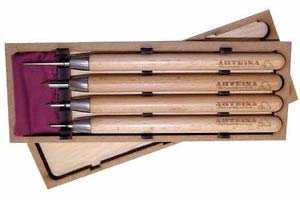
An etching needle comes with a sharp tip to help you engrave on the drawing exterior. It has a handle to hold comfortably while working.
Usually, the handles are made from wood or plastic. The tips are made from steel/metal. To create delicate patterns, there is also a diamond-tip drypoint needle available on the market.
Use: It’s the most common tool used for drypoint techniques. The point of the needle is used to create fine, delicate patterns on the metal surface.
2. Scraper
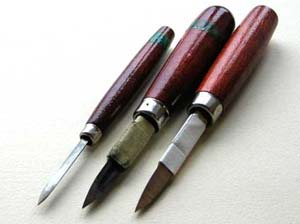
A scraper is a handy tool that comes with two sharp blades on each of its three sides. Usually, the blades are made of 50% tungsten and 50% carbon materials.
Use: Made a mistake?
The scraper will remove it for you! A scraper removes any unintentional marks made on the plate. Once removed, you have to put oil on the image and burnish the scrap marks away.
3. Mezzotint Rocker
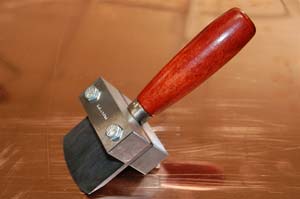
It actually looks almost similar to a chisel!
A mezzotint rocker is used in the drypoint technique. It’s a metal tool that has tiny little teeth on its front portion.
Use: Mezzotint is used to produce luscious and rich black texture on the surface. To create such a pattern, you have to hold the tool at a certain angle and rock it backward and forward carefully.
4. Burnisher
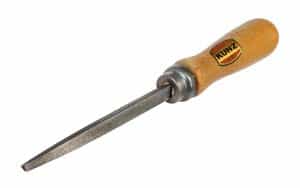
A burnisher is an essential tool in an artist’s toolbox!
It’s a piece of rod-shaped equipment, which is made of steel. There are different versions available for you to choose from. some prefer wooden handles, some like the metal ones. Some burnisher even comes with a needle/scraper on one side as a bonus!
Use: It almost works similarly to a scraper. A burnisher helps remove any unwanted line from your artwork. It also helps adjust the tone of your work and make it free from errors.
5. Roulette Wheels
It’s a cylindrical-shaped toothed tool that has a wheel on its head.
The wheel has small little dots over its surface. There are different variations to these dots: such as, fine, medium and coarse.
Use: Roulette wheel is used to create amazing tones and shades on your working surface. The wheels move back and forth position to leave a satin finish on the printing plate.
6. Engraving Burin
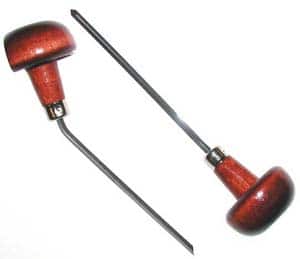
An engraving burin has a metal shaft that’s slightly bent. The diamond or lozenge-shaped point looks a bit scary but is actually really helpful when it comes to working. At the end of the shaft, there is a wooden handle to hold the tool comfortably.
Use: It does what its name suggests, it engraves! It cuts firmly onto the surface and creates a recessed line on the plate.
Block Printmaking Supplies
7. Block
The first thing you will need for Block printmaking is some “Blocks”. It could be made of wood, rubber or even linoleum. Here you can get details about block printing supplies.
Use: The block is used as a flat material on which you will do all the carving works. For creating bold images, we recommend using wood and lino, while metal and acrylic sheets are better off reserved for the finer images.
8. Brayer
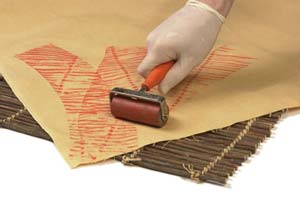
Brayer is a hand-held rubber roller. Usually, you will find 2 different types of brayers to work with: Hard rubber brayer and soft rubber brayer.
Use: It’s used to apply ink on the surface of the block. It helps apply the paint in an even manner and does your job much faster than other tools do.
9. Etching Press
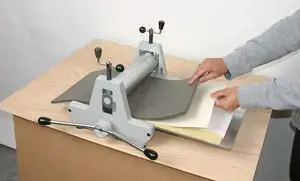
An etching press features two metal rollers that help transfer the image from the matrix to a piece of paper.
They are found in different sizes and can be adjusted to the varying widths of the blocks.
Use: It helps transfer your image onto the desired surface. Typically, this pressing machine is used for creating larger images.
10. Baren
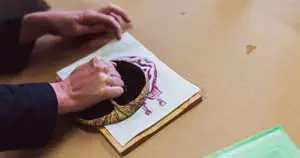
It’s a hand-held device that’s shaped like a round pad. It provides a flat surface that distributes the pressure that’s given on top of it evenly.
Use: It helps lift/press ink from the wooden/metal blocks. When you rub baren over a piece of paper, it forces the ink to get printed on the desired surface quite easily.
11. Woodcutting Tools
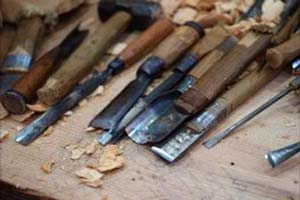
To curve the wooden blocks, you will be needing lots of woodcutting tools to help you out. These include a variety of knives, U-gouges, V-gouges, flat chisels etc.
Use: Woodcutting equipment help carve fine details on the blocks. As they are mostly made of High-carbon steel or metal, these tools add sharpness to your project. Also, you can take a look at other tools resource toolsinstitute.com for more projects.
Lithography Tools
12. Lithographic Crayons And Pencil
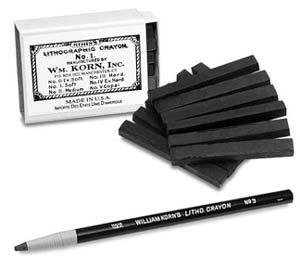
Lithographic crayons come in various shapes and sizes. The crayons contain tallow or stearic acid, wax, resin, soap, soot and some other components. Depending on the proportion of the components, the hardness of the crayon might vary a lot.
Use: Lithographic crayons and pencils are used for drawing images on Lithography stones. They are great for sketching fine details on the surface and can be re-sharpened before the next use!
Read More: My UV Resin is Sticky – why? Here’s what makes UV resin sticky plus more helpful tips and info!
13. Abrasive
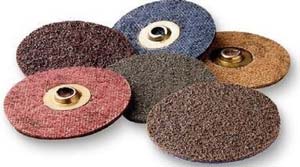
Abrasive materials are hard substances that are used in lithography art. These materials include Carborundum grit and Sand abrasive.
Use: Abrasives are used to remove the previous image that’s been printed on the surface. For instance, if you grain a litho stone with a coarse grit, the dark part of the image starts to turn a bit lighter. Then, after washing the stone, you can proceed to remove the lighter part in the same process.
14. Roller
There are different kinds of rollers out there that are used in lithography art. The rollers can be made of a mix of different components, such as Nitril-Rubber-PVC, Nylon flock, Cotton flock etc. Each of the rollers come with different characteristics.
Use: Rollers help transfer ink onto the surface. Depending on the structure of the surface, you should select a designated roller that does the job properly.
For instance, a smooth roller can transfer delicate ink quite easily. Heavier rollers, on the other hand, are better for transferring non-drying roll-up ink.
Screen Printing Supplies
15. Screen Frame
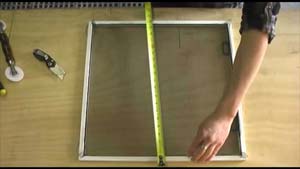
A screen frame is basically a piece of netting stretched over a particular frame. This netting could be made of different materials, such as polyester, synthetic polymer, wood, aluminum etc. Here is the complete list that you need to start a printing business.
Use: A screen frame is used for transferring ink onto a flat surface. The hole of the mesh is utilized for creating a detailed pattern of a particular design.
16. Emulsion And Fillers
Emulsion and fillers are two essential items used in screen printing. An emulsion is a thick liquid that’s sensitive to UV (Ultra-Violet ray) light. And screen filler is a fluid that’s used to block out all the spaces that you don’t want to print upon.
Use: When exposed to UV-light, the layer of emulsion gets cured. On top of the artwork, the emulsion creates a negative stencil that allows the ink to be printed on the desired surface.
Screen filler is usually sprayed on the desired surface. When the fluid is dry, pour cold water on the screen and your surface will be ready to get print!
17. Squeegee
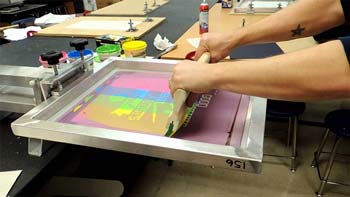
A squeegee is a thin, flexible rubber or plastic blade that comes with a wooden/metal handle. These squeegees are available in different sizes.
Use: It’s used to force ink through the screen. Squeegees are an essential part of screen printing as they help flood the screen and transfer images to the desired surface/garment. Usually, there are 2 different types of squeegees available: Wooden and Aluminum.
18. Spatula
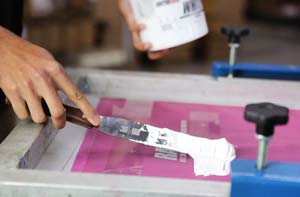
It’s also known as an ink knife/pallet knife. A spatula looks similar to a regular knife. Except that it has a flat head instead of a sharp one. It’s usually reinforced with a solid wooden/plastic handle to hold it comfortably.
Use: A spatula is used for distributing ink all over the surface in a quick and easy way. The smooth edge of the spatula helps scrape up the ink quite easily.
Final Words
When you first heard the word “Printmaking”, did you think of books, newspapers and paper media?
I bet you did!
As you can see, the world of a printmaker is quite different. It’s full of blocks, arts, ink and most importantly, creativity!
Did the printmaking tools list in our article intrigue you to take a step forward and test the water to see if you like it?
Give it a try at least!
We would love to see some new rising talents from this industry!
As always, stay blessed and keep trying new things to turn your daily adventure into a new-found talent!
More related resources that you should know: